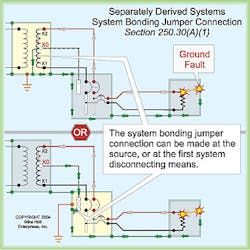All questions and answers are based on the 2005 edition of the NEC.
Q. Where must the system-bonding jumper at a transformer be installed?
A. The metal parts of the separately derived system must be bonded to the secondary grounded neutral terminal by the installation of a system-bonding jumper. This bonding jumper ensures that dangerous voltage from a secondary ground fault can be quickly removed by opening the separately derived system circuit's overcurrent protection device [250.2(A)(3) and 250.30(A)(1)].
Danger: During a ground fault, metal parts of electrical equipment, as well as metal piping and structural steel, will become and remain energized and thereby provide the potential for electric shock and fire if the system bonding jumper isn't installed.
The system-bonding jumper can be installed at the transformer, the first system disconnecting means, or any point in between the transformer and the first disconnecting means, but not at both locations (Figure at right).
Caution: Dangerous objectionable current will flow on conductive metal parts of electrical equipment as well as metal piping and structural steel, in violation of 250.6(A), if the system-bonding jumper is installed at the transformer and the secondary system disconnecting means.
Q. My instructor says the Code only requires you to twist 14 and 12 AWG copper ground wires to splice them. Is he right?
A. No. The Code requires all conductors to be spliced by a splicing device identified for the purpose or by exothermic welding [110.14(B)]. Also, equipment grounding (bonding) conductors associated with circuit conductors that are spliced or terminated on equipment within a metal outlet box must be spliced together or joined to the box with devices suitable for the purpose [250.148(A)].
Note: You don't need to twist the conductors together prior to the installation of a twist-on wire connector.
Q. The instructions for the UL Listed standby generators I install state, “Drive a ground rod and bond it to the frame of the generator enclosure.” The generator isn't a separately derived system because it uses a solidly bonded neutral in the transfer switch. Why do they say it must be grounded to an approved earth ground?
A. Probably because the engineer who wrote the specifications and the engineer at UL who reviewed the instructions think the earth serves some safety purpose. I have a standby generator with an unswitched neutral in the transfer switch, and I didn't install a ground rod. The only time an earth ground is required by the NEC for a generator is when the generator meets the definition of separately derived system [250.30(A)(3)].
According to Art. 100, the generator would only be a separately derived system where there's no direct electrical connection to the utility supply conductors. In other words, the neutral is also switched in the transfer switch.
Having a dispute with the local inspector? Send your question to [email protected].
About the Author

Mike Holt
Mike Holt is the owner of Mike Holt Enterprises (www.MikeHolt.com), one of the largest electrical publishers in the United States. He earned a master's degree in the Business Administration Program (MBA) from the University of Miami. He earned his reputation as a National Electrical Code (NEC) expert by working his way up through the electrical trade. Formally a construction editor for two different trade publications, Mike started his career as an apprentice electrician and eventually became a master electrician, an electrical inspector, a contractor, and an educator. Mike has taught more than 1,000 classes on 30 different electrical-related subjects — ranging from alarm installations to exam preparation and voltage drop calculations. He continues to produce seminars, videos, books, and online training for the trade as well as contribute monthly Code content to EC&M magazine.
